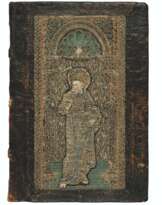ID 470091
Lot 37 | Thomas Aquinas (c1225-1274)
Estimate value
£ 25 000 – 35 000
Thomas Aquinas, Commentary on the Third Book of the Sentences, Bologna, third quarter 13th century
THOMAS AQUINAS (c.1225-1274), Commentary on the Third Book of the Sentences, in Latin, illuminated manuscript on vellum [Bologna, third quarter 13th century]
The quintessential 13th-century Italian university scholastic textbook, contemporaenous to the life of its author Thomas Aquinas, and owned by Giacomo Manzoni, one of the prominent players in the movement for the independence and unification of Italy.
310 x 227mm. 121 leaves, complete, catchwords and pinpricks survive, occasional signature marks such as 'a2' and 'a3' on ff.6 and 7, 54 lines of text in two columns, ruled space: 217 x 143mm, paragraph marks alternately of red or blue, two-line initials alternately of red or blue with flourishing of the other colour, illuminated initial with an orange-red beast-mask in the infill, informally written distinctione headings (faint dampstaining to upper margins, cuts or tears in the margins of 10 leaves, a few wormholes at front and back, narrow stain across 22 lines of text on folio 7). 19th-century sheep-backed speckled paper boards (somewhat worn and scuffed).
Provenance: (1) The manuscript was likely produced in Bologna and within the lifetime of the author. It is carefully corrected throughout in a variety of hands. Different readers have jotted nota bene marks or maniculae symbols in the margins and the list of contents, probably added in the 14th-century, is in an Italian hand.
(2) Count Giacomo Manzoni (1816-1889), bibliographer and Italian republican: letter pasted inside the upper cover dated 14 February 1880 and addressed to Giuseppe Oreglia of the Society of Jesus in Rome. It informs him that three scholastic manuscripts owned by Manzoni and purchased by him some 30 years earlier in Savoy from a man who had acquired them in France, were being brought to him. Manzoni was perhaps seeking Oreglia's opinion on the date and origin of the manuscripts - in the letter he suggested that all three were French and of the mid-14th-century. Oreglia, of the community of La Civiltà Cattolica, had, when still a student, assisted with the foundation of the periodical of that name and continued to write for it throughout his life. It is possible that he was consulting the manuscripts in connection with his research.
Manzoni had played a prominent part in the movement for the independence and unification of Italy: he took part in all the campaigns in the Veneto in 1848 and when the Repubblica Romana was proclaimed in 1849 he was made its Finance Minister. In an effort to get funds Manzoni was involved in negotiations with Palmerston that would have resulted in the sale of the treasures of the Vatican galleries and museums. His refusal to allow this hastened the Republic's inevitable fall. He fled Rome, joined Garibaldi in San Marino and then moved to Corfu. During his exile and travels Manzoni expanded the library that he had inherited from his great-uncle, Bartolomeo Borghese; his purchases included the collection of Guglielmo Libri and a considerable number of books bought after the sale of the Wellesley library. Manzoni returned to Rome in 1874 and at his death there he owned 25,000 volumes. His wish that the collection should remain intact was not fulfilled, and it was sold by G. Sangiorgi in the Palazzo Borghese: Catalogue de la bibliothèque de feu M. le comte Jacques Manzoni, 4 parts, Città di Castello 1892-94. There were 220 manuscript volumes in the collection and 186 of these were offered for sale on 23 and 25 April 1894; the catalogue did not include the present manuscript.
(4) Shelf-mark R.II.18 inside upper cover.
(5) English private collection.
(6) Christie's, 29 November 2000, lot 10.
Content: List of titles ff.1-4; Problemata tertii libri fratris Thome [...], beginning 'Ad locum unde exeunt flumina revertuntur [...]' ff.5-121.
Peter Lombard composed his Sentences in the late 1140s as an aid to the study of the Bible and the Church fathers: by the early 13th Century they were the accepted compilation of theological doctrine. The study of the Sentences was obligatory for Aquinas as the second and third years of his degree as Master of Theology in Paris. His Commentary on the Sentences is nonetheless his first great work, and it has been suggested that all his major conclusions are already to be found in it. The Commentary on the Third Book considers the efficient causes of the soul's return to God, with a consideration in particular of the nature and consequences of the Incarnation.
| Artist: | Thomas Aquinas (1225 - 1274) |
|---|---|
| Genre: | Religious genre |
| Artist: | Thomas Aquinas (1225 - 1274) |
|---|---|
| Genre: | Religious genre |
| Address of auction |
CHRISTIE'S 8 King Street, St. James's SW1Y 6QT London United Kingdom | |
|---|---|---|
| Preview |
| |
| Phone | +44 (0)20 7839 9060 | |
| Buyer Premium | see on Website | |
| Conditions of purchase | Conditions of purchase |






